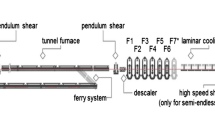Abstract
Slivers are a common defect observed in rolled steel products such as plates and strips. This is one of the causes of rejection for applications requiring good surface finish. Typically, slivers are categorized into nonmetallic inclusion based and iron oxide (FeO) based, but their origin could be many. Unlike slivers originating from nonmetallic inclusions, analysis of FeO-type slivers is often not conclusive on the source or origin. Proper inspection and conditioning processes of slab surface before rolling can ensure good surface quality. Based on inspection results and metallographic analysis of downgraded rolled products, it was found in the present study that the majority of the slivers were FeO related. To minimize downgrading at coil stage or reduce salvaging activity, identification of the causes of FeO-type slivers became necessary. A systematic study was undertaken to establish a link between various slab surface defects leading to FeO-type slivers in hot rolled coils. Weld marking near the defects in slabs proved to be a novel technique to verify and confirm slab defect and its manifestation into hot rolled coils. Based on the appearance of slivers and severity, visual standards were developed illustrating characteristics and severities of slab defects, and the slab surface conditioning norms. The visual standard became useful in making decisions on the conditioning need of the slab and timely feedback to the upstream process. The paper describes in detail the methodology and approach adopted for this study.


Similar content being viewed by others
References
W.H. Emling, B.V. Lakshminarayana, An AISI-sponsored collaborative project on FeO-type sliver defects. Steelmak. Conf. Proc. 83, 11–16 (2000)
H.T. Tasi, W.J. Fisher, D.E. Hazelton, Characterization and countermeasures for sliver defects in cold rolled products. Steelmak. Conf. Proc. 73, 17–28 (1990)
E.P.M.A. Amitava Ray, Some revelation in the investigation of defects in steel products. Mater. Sci. Forum 492–493, 627–634 (2005)
A. Ray, D. Mukherjee, S.K. Dhua, S. Mishra, S.K. Bhattacharya, Microstructural features of sliver defects in hot-rolled low-carbon steel sheets. J. Mater. Sci. Lett. 12, 1148–1150 (1993)
J.K. Brimacombe, F. Weinberg, E.B. Hawbolt, Formation of longitudinal, midface cracks in continuously-cast slabs. Metall. Trans. 10B, 279–292 (1979)
M. Wolf, W. Kurz, The effect of carbon content on solidification of steel in the continuous casting mold. Metall. Trans. 12(B), 85–93 (1981)
A. Grill, J.K. Brimacombe, Influence of carbon content on the rate of heat extraction in the mould of a continuous casting machine. Ironmak. Steelmak. 140, 76–79 (1976)
B. Mintz, Hot ductility of steels and its relationship to the problem of transverse cracking during continuous casting. Int. Mater. Rev. 36, 187–217 (1991)
Y. Maehara, K. Yasumoto, H. Tomono, T. Nagamichi, Y. Ohmori, Surface cracking mechanism of continuously cast low carbon low alloy steel slabs. Mater. Sci. Technol. 6, 793–806 (1990)
T.K. Roy, Elimination of surface defects in high tensile steel for wheel rim application. J. Fail. Anal. Prev. 17, 93–99 (2017)
W.P. Barker, The prevention of steelmaking source iron oxide defects. Steelmak. Conf. Proc. 75, 549–555 (1992)
K.J. Lin, M.J. Lu, C.J. Chen, C.L. Chou, F.I. Wei, The relationship between the longitudinal crack of slab and the surface quality of hot-rolled strip. Technol. Train. (Taiwan) 19, 125–139 (1994)
Acknowledgments
The authors thank the personnel of LD2&SC Shop, Hot Strip Mill and Planning Department of Tata Steel, for their support and help in carrying out this study. The help and cooperation received from the inspectors of slab and coil yards and metallographic analysis done by R&D and scientific services team are also appreciated. Finally, thanks are due to the Tata Steel Management for giving permission to publish this work.
Author information
Authors and Affiliations
Corresponding author
Rights and permissions
About this article
Cite this article
Roy, T.K., Gorain, N.C. & Suresh, S. A Study to Relate Slab Surface Defects with FeO-Type Slivers in Hot Rolled Product. J Fail. Anal. and Preven. 19, 131–137 (2019). https://doi.org/10.1007/s11668-018-0575-5
Received:
Revised:
Published:
Issue Date:
DOI: https://doi.org/10.1007/s11668-018-0575-5




